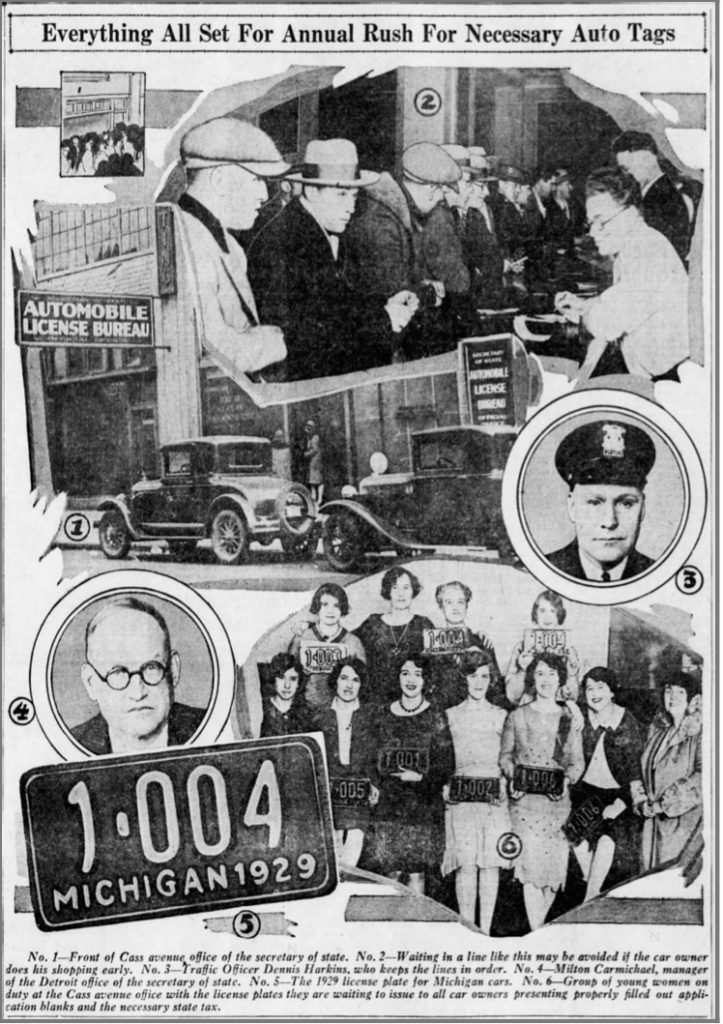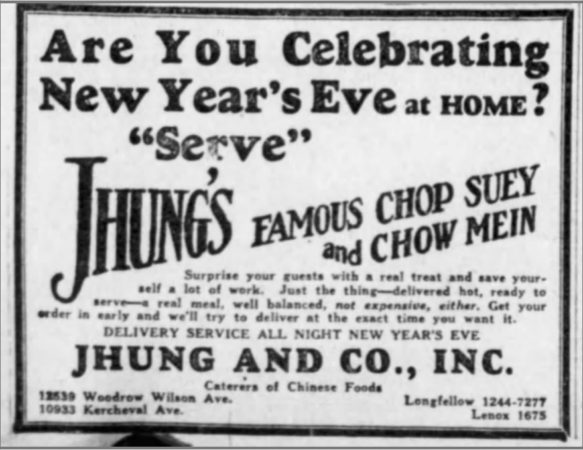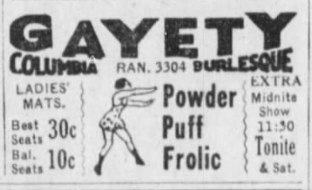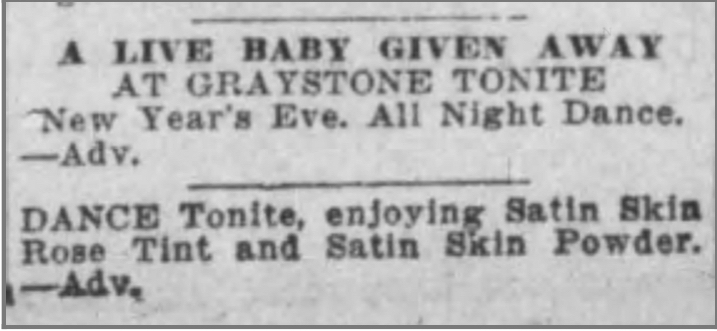Even if, like me, your idea of a rockin’ New Year’s Eve is two glasses of wine and asleep by 11, there’s something magical about the night. The bright and shining hope for the future. The resolutions to become your best self. The traditions of the season: champagne toasts, friendly gatherings, dancing, waiting in line for your license plate…
People have celebrated the new year in pretty much the same ways for many many years, and Prohibition didn’t change that a whole lot. You had a few options for festivities: private parties at home; lavish public balls at places like the Book Cadillac, famed nationally for its revelries; private club fetes such as the ones hosted by the Elks Club and the Detroit Athletic Club; or traditional Watch Night services at churches all over town.
One tradition that hasn’t, fortunately, survived is the annual December rush for license plates. For too many years, vehicle plates were only available in the month of December. Stiff penalties, including towing and impounding, were assessed beginning January 1st for any car with old plates. As more and more Detroiters became car owners, the beleaguered staff at the Secretary of State simply couldn’t keep up with the massive rush. On New Year’s Eve 1925, thousands of motorists waited for up to five hours in the frigid cold as 20,000 applications were processed in one day. It still wasn’t enough to keep up with the vast crowds, though, and eventually they rioted, storming the office at Cass and Peterboro and overwhelming the 30 or so police officers set to protect it. After that, extensions were offered, but I’ll keep this in mind the next time I’m stuck at the SoS for an hour.

Once that was out of the way, you were free to carry on the celebrations. Many folks, especially in the later years of Prohibition, chose to stay at home. There were a couple of reasons for this: first, enforcement agents were definitely not going after the small fry, so it was far easier (and more relaxing) to hang out with a few close friends and swig away without interference. Second, and here’s a reason after my own heart: CHINESE FOOD DELIVERY. That’s right, If the Modern Hostess wasn’t into sullying her party dress, she could simply pick up the phone and the finest in chop suey would arrive by car directly to her door, fully cooked, piping hot, and ready whenever she asked.

How is it, then, that 90 years later I still can’t get decent Chinese food delivery? Oh how far the mighty have fallen. Or, if exotic Asian spices weren’t your thing, there were plenty of simple but elegant menu suggestions, many of which featured oysters (yum), roast chicken (also yum), and finger foods. Sounds like the perfect evening to me.
The tradition of Watch Night was popular all through the years before the second World War across many Christian denominations. For Catholics, New Year’s Day was a Holy Day of Obligation celebrating the Solemnity of Mary (growing up Catholic, I always saw this as a particularly cruel obligation: who wants to go to mass hungover as heck?). Protestants, especially Methodists, also celebrated a vigil that night as well, and the tradition held significance in Detroit’s increasing African-American population. For many folks, booze or not, New Year’s was a solemnly joyous occasion rather than one of loud revelry.
If you were more adventurous, though, there were plenty of shenanigans to be found! Those fortunate elite celebrated in sumptuous club parties at the Detroit Athletic Club, the Elks and the Masons. Private lockers at the clubhouses came in handy for bottle storage, so the champagne and gin often flowed unimpeded. The entertainment at these shindigs was as lavish as the food and drink. The Elks Club, for instance, hosted three floors of entertainment, from a casual basement Rathskellar with German buffet to a replica of a Venetian gondola. The DAC handed out Ouija boards to each table in 1921. Prohibition enforcement’s “tuxedo squad” theoretically kept a watchful eye on the “hip flask crowd,” trying to blend in in their ill-fitting rented formal wear, but, as the Free Press noted in a 1922 headline, “Detroit Waiters Stricken with Astigmatism, Rumor Declares,” and plenty of high-octane liquid made it into the virgin punch all over town.
For those not fortunate to have country club connections, cafes and dance halls hosted equally flashy parties for the plebes. The University of Michigan Mime Club performed an annual “Merrie-Go-Round” opera at midnight, which truly begs the question: what the hell is an opera performed by mimes, anyway? High school kids crashed their parents’ parties or held those of their own, and Howard “Sonny” Kresge, son of the KMart millionaire and prominent temperance advocate (Kresge donated a half million dollars to the Dry cause), was spectacularly busted at age 17 when he got smashed at a Hotel Statler party hosted by the Alpha Iota sorority. Details of his transgressions were kept mum, but rumors stated that it involved his slapping partygoers, male and female, with a wet towel to the face. Whatever else he did, it was enough to shut down the whole hotel and make the papers. Dad must’ve been thrilled.
Burlesque shows and movies were popular options as well, with many theatres booking top acts at 10 and 11 pm to draw the crowds.

By far the biggest romp of the season was the massive party at the Book Cadillac. If, as Chicago papers reported, they were to have a “rip-snorting, furniture-breaking, ear-splitting, cork-pulling celebration,” Detroit would certainly go to-to-toe on partying. As the newspapers tallied the cost of a case of champagne like they compared stock market prices, it became increasingly obvious over the years that nothing was stopping drinkers in Detroit from celebrating the new year. The same year that Sonny Kresge was whooping it up at the Statler, the Book Cadillac had turned away 4,000 hopeful party-goers due to lack of space. Bootleggers reported their highest sales of champagne ever, in wet or dry times, and many spots stayed open right through the night, advertising breakfast at 7 am.
Competition for the deepest pockets was fierce, but most places filled up quick. The Arcadia club posted an annual front page advertisement betting $1,000 (against whom it is unclear) that theirs would be the biggest crowd in town. The ads boasted “ALL NIGHT DANCE, 5,000 Noise Makers Free, Mardi Gras Carnival Yama-Yama Band of 30 pieces. Admission 15c and $1.00” Sounds exhausting. Also, what is a Yama-Yama band, and where can I go see one? An equally confusing, if not downright disturbing, advertisement came in 1927 from the famed Graystone Ballroom. Pictured below, and without any explanation: a live baby giveaway.

With all the confusing and obscure traditions that have fallen by the wayside, though, New Year’s Eve in Detroit would be pretty much recognizable to any of us today. Couples went out to fancy dinners dressed to the nines while bands played and champagne flowed. Families celebrated at home. The hoity toity supped in private with attendants while the hoi polloi rocked out in the street with noise makers and streamers. And, although the Great Depression cast a somber pall on some celebrations and caused gloomy correspondents to proclaim “Resolutions are outmoded…The changing world has just about confined these to civic associations, legislative bodies and political parties,” the great mass of Detroiters remained, year after year, hopeful and joyous at the turning of the new year. With or without the free baby giveaways.
Happy New Year friends. May it bring you love, peace and plenty of festive frolics.
Be First to Comment